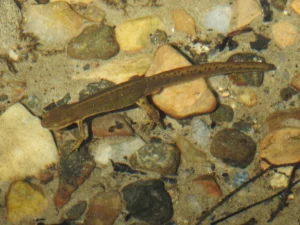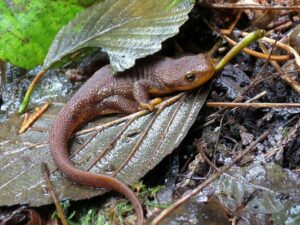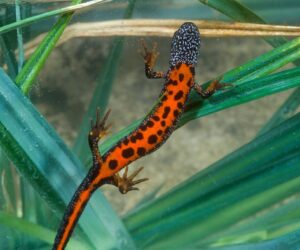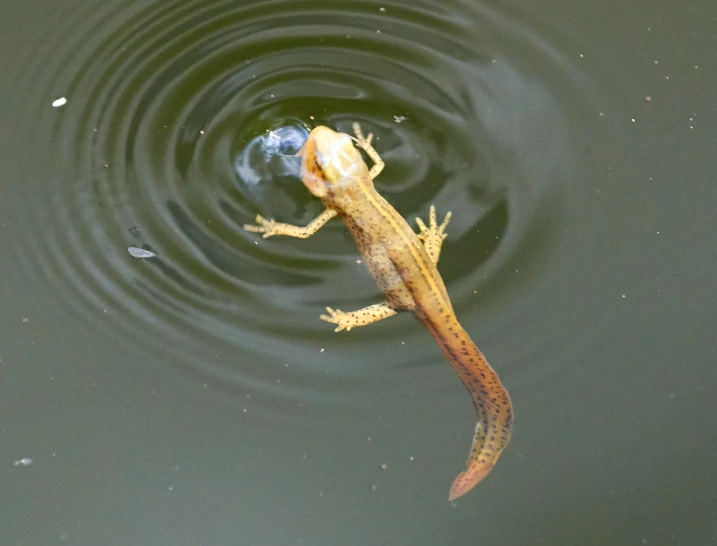You’re crouched by a quiet forest pond and notice a small newt moving slowly across the damp soil, stopping every now and then. You might wonder: does it drink from the pond? Do newts even drink water?
Newts don’t drink water the way we do. They get most of the moisture they need straight through their skin. Their skin is thin and soft, which lets water and oxygen pass right into their bodies.
It’s a really interesting way to live, and it changes how we think about newts and their connection to water.
How Newts Absorb Water Through Their Skin
Unlike mammals, newts don’t have lips or tongues to drink with. Their skin works like a sponge.
Moisture from ponds, puddles, or damp soil moves straight into their blood through the skin.

This is called cutaneous absorption, which just means “absorbing water through the skin.” It’s very efficient.
A newt resting in a shallow puddle can soak up enough water to stay hydrated for hours or even days.
Because of this, newts have to keep their skin wet all the time. Dry air or long heat can be dangerous.
You’ll often see them hiding under moss, leaves, or in shallow water, these spots keep their skin wet enough to survive.
Do Newts Ever “Sip” Water?
Sometimes, you might see a newt dipping its mouth into a puddle or pond and think it’s drinking.
But really, most of the water comes through the skin, not the mouth.
Any behavior that looks like drinking usually happens when they are eating or just moving around in the water.
Their bodies are built to rely on skin absorption, not drinking like we do.
Why Moisture Is Very Important for Newts
A newt’s need for wet skin affects everything in its life:
-
Movement: Dry skin makes it harder to move. They can get slow or even stuck on rough ground.
-
Breathing: Oxygen passes through their skin too, so dry skin makes it harder to breathe.
-
Survival: Too long without moisture can cause deadly dehydration.

That’s why you usually find newts in damp forests, near streams, or in wetlands. Even a few feet from water, if the ground is dry, it can be too harsh for them.
How Newts Stay Wet in Different Places
Not all newts live in water all the time. Some spend most of their time on land, only going to ponds to breed. Being on land means they have to be careful to stay wet:
-
Under moss or leaf litter: They find cool, damp spots that slow water loss.
-
Shallow burrows: Digging little holes in the soil helps trap moisture.
-
Rainy nights: Rain gives perfect conditions for moving around and staying wet.
Wherever they go, moisture decides when they are active. That’s why you almost never see newts out in hot, dry weather, they just can’t survive without water.
How Skin Absorption Shapes Newts’ Behavior
Because newts rely on wet skin, they are very sensitive to humidity. They often:
-
Move mostly at night or when it’s raining.
-
Avoid hot, dry sunlight.
-
Stay in shaded, damp areas during the day.
This also explains why newts in tanks need moist setups or shallow water dishes. Without enough moisture, they can get dehydrated even if they look active.
Do All Newts Absorb Water the Same Way?
Different kinds of newts do it a little differently:
-
Aquatic newts live mostly in water, so they stay wet all the time.
-
Semi-land newts rely on damp soil and leaves. They might soak in shallow puddles at night.
-
Young newts are more sensitive and need wet conditions all the time to survive.

No matter the type, the main idea is the same: their skin is how they stay wet.
Can Newts Survive Without Water for Long?
Not really. A dry day can be dangerous. Newts can survive out of water for a few hours if the air is humid and the ground is damp.
But long dry periods can cause dehydration, skin damage, and eventually death.
That’s why you often see newts hiding under leaves or underground during droughts.
They aren’t just hiding, they’re protecting their skin so it can absorb water and help them breathe.
How Water Needs Affect Newts’ Breeding
Water isn’t just for staying wet, it’s very important for reproduction. During breeding season, newts go back to ponds or streams to lay eggs.
Being hydrated lets them stay active on land while looking for mates or spots to lay eggs.
A newt with wet skin can move further, hunt better, and reach water safely. Without enough moisture, their activity slows, and survival drops.
Watching Newts in Captivity
In tanks, you might see newts hanging out in shallow water dishes. It can look like they’re drinking, but they’re really keeping their skin wet.

Giving them damp moss, shallow water, and high humidity keeps their skin working properly.
Even short times without moisture can stress them and affect appetite, movement, and health.
Conclusion
So, do newts drink water? Not like mammals or birds. They absorb it through their skin, taking moisture from ponds, puddles, soil, and leaves.
This way is simple, efficient, and very important for survival.
Newts’ connection with water is quiet but essential. Their skin has to stay wet, not just for hydration but also for breathing, moving, and reproduction.
Watching a newt press against damp soil or slip into a shallow puddle is like seeing a living sponge at work, balancing life between land, water, and staying alive.
In the hidden corners of forests, wetlands, and mossy pond edges, water isn’t just a drink. For newts, it’s life itself.
Hi, my name is Ezra Mushala, i have been interested animals all my life. I am the main author and editor here at snakeinformer.com.

